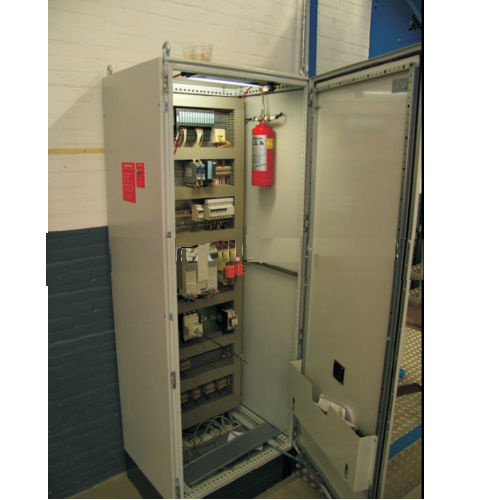A CO2 suppression system, or carbon dioxide suppression system, is a fire protection system that uses carbon dioxide (CO2) as the extinguishing agent to control and extinguish fires in various environments, including industrial facilities, data centers, laboratories, and other high-value areas. CO2 is a colorless, odorless gas that is effective at suppressing fires by displacing oxygen, which is essential for combustion.
# Here are the key components and features of a CO2 suppression system:
1. CO2 Storage: The system typically includes a storage tank or multiple tanks containing pressurized liquid CO2. The storage capacity is determined based on the protected areas volume and the fire hazard classification.
2. Distribution System: A network of pipes and nozzles is used to distribute the CO2 from the storage tank(s) to the protected area. The distribution system may include flexible hoses or rigid piping, depending on the specific application.
3. Detection and Control: Fire detection and control equipment, such as smoke detectors, heat detectors, or flame detectors, are integrated into the system. When a fire is detected, the system is activated automatically or manually, releasing CO2into the protected area.
4. Discharge Nozzles: Nozzles are strategically placed to ensure even distribution of CO2 throughout the protected space. The discharge nozzles are designed to optimize the gass flow and distribution pattern.
5. Release Mechanism: The release mechanism can be pneumatic or electrical and is activated upon fire detection. It opens valves in the CO2storage tanks to release the gas into the protected area.
6. Warning Systems: Warning alarms and sirens are often incorporated to alert occupants to evacuate the area when the CO2 system is activated, as CO2can displace oxygen and pose a suffocation risk.
7. Interlocking Systems: CO2suppression systems are typically interlocked with other safety systems, such as building management systems, to ensure coordinated responses to fires.
8. Remote Control: Some systems offer remote control and monitoring capabilities, allowing operators to activate the system and monitor its status from a centralized location.
CO2suppression systems are particularly suitable for fires involving flammable liquids, electrical equipment, and other hazards where water-based suppression systems may be ineffective or cause further damage. However, because CO2can displace oxygen, it is essential to ensure that areas protected by these systems are evacuated before activation to prevent harm to occupants.
# Frequently Asked Questions:
Q. What is a CO2suppression system?
Ans: A CO2suppression system is a fire protection system that uses carbon dioxide (CO2) as an extinguishing agent to control and extinguish fires. It works by displacing oxygen in the protected area, effectively removing one of the essential elements for combustion.
Q. Where are CO2suppression systems commonly used?
Ans: CO2suppression systems are commonly used in various settings, including data centers, industrial facilities, power plants, laboratories, museums, and storage areas with sensitive or valuable equipment. They are suitable for fires involving flammable liquids, electrical equipment, and other hazards.
Q. How does a CO2suppression system work?
Ans: When a fire is detected, the system releases CO2from pressurized storage tanks into the protected area. The CO2displaces oxygen, reducing the oxygen concentration below the level required for combustion, thereby suppressing the fire.
Q. Are there different types of CO2suppression systems?
Ans: There are two main types of CO2suppression systems: high-pressure systems and low-pressure systems. High-pressure systems store CO2as a gas, while low-pressure systems store CO2as a liquid. The choice of system depends on the specific application and requirements.
Q. Is CO2safe for humans in the protected area?
Ans: CO2can be harmful to humans if present in high concentrations. Therefore, CO2suppression systems are designed to be used in unoccupied or evacuated areas. Warning systems are typically included to alert people to evacuate before system activation.
Q. What types of fires are CO2suppression systems effective against?
Ans: CO2suppression systems are particularly effective against Class B (flammable liquid) and Class C (electrical) fires. They work by smothering the fire and disrupting the combustion process.
Q. Are there any limitations to CO2suppression systems?
Ans: CO2suppression systems may not be effective against fires involving certain metals or other materials that can continue to burn in an oxygen-depleted environment. Additionally, the system may not provide post-fire cooling, so re-ignition can be a concern.
Q. How often should CO2suppression systems be inspected and maintained?
Ans: Regular inspections, testing, and maintenance are critical to ensure the systems reliability. The specific maintenance schedule and requirements should follow local regulations and industry standards. Typically, inspections are conducted semi-annually or annually.
Q. Can CO2suppression systems be integrated with other safety systems?
Ans: Yes, CO2suppression systems can be integrated with fire detection systems, alarm systems, and building management systems to provide a comprehensive fire protection strategy.
Q. Are there environmental considerations when using CO2as a suppression agent?
Ans: CO2is not ozone-depleting, but it is a greenhouse gas. Therefore, its important to consider environmental impacts and adhere to regulations when using CO2suppression systems. Some jurisdictions may require systems to be equipped with automatic discharges to prevent excessive CO2release.
Q. What should I do in case of a CO2suppression system activation?
Ans: If a CO2suppression system is activated, its important to evacuate the protected area immediately. The CO2can displace oxygen, posing a suffocation risk in enclosed spaces.
